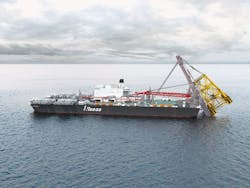Offshore staff
DELFT, the Netherlands – Repsol Norge has awarded Allseas a contract to remove, transfer, load-in to shore, and dispose of the Gyda platform in the southern Norwegian North Sea.
The contract covers both the 18,000-ton topsides and 11,200-ton jacket, to be removed by the Pioneering Spirit, with an option for reinstallation on another field. According to Allseas, this would be a first for a fixed installation off Norway.
There is a further option for the removal, transfer, load-in and disposal of the jacket’s 32 conductors, weighing a total 3,100 tons.
BP originally developed Gyda, which is situated between the Ula and Ekofisk fields, via a combined drilling, accommodation and processing facility with a steel jacket in 66 m (216 ft) water depth.
The platform started producing in 1990; a decommissioning plan was submitted in 2016; and Gyda is now producing in parallel with plugging of the wells.
As the platform remains in a good technical condition, Repsol considered a re-use. However, because the jacket was vertically fabricated and installed, it would not be able to sustain loading in the horizontal position during transport.
Allseas and Repsol spent over a year reviewing ways of moving the platform from its current location and bringing it to shore for disposal. The solution, transporting the jacket in a near-vertical position (60°) with the Pioneering Spirit’s unique jacket lift system led to the contract award.
Removal is due to take place some time between late 2020 and 2023.
Allseas has selected Kvaerner for offshore preparations followed by dismantling and recycling of the topsides and jacket structure at the Stord disposal facility on the west coast of Norway.
The method for disposal developed by Repsol, Allseas, and Kvaerner allows for a potential re-use and re-deployment of the facilities at another offshore Norway, should Repsol decide. For this reason, Kvaerner’s scope of work includes preservation of the Gyda installation.
Stord has a purpose-built site for deconstruction and recycling of old offshore platforms, next door to Kvaerner’s facility for construction of new platforms. The co-location allows the company to optimize HSE, use of facilities, specialist personnel and capacity.
Typically, the company claims to be able to recycle more than 98% of a platform.
Kvaerner also constructed the Gyda platform. The installation includes a topsides with drilling systems, living quarters and process facilities, sitting on a steel jacket substructure.
09/20/2019



